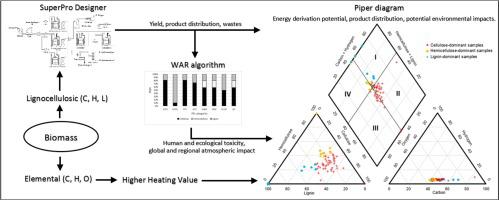Journal of Analytical and Applied Pyrolysis ( IF 5.8 ) Pub Date : 2020-12-30 , DOI: 10.1016/j.jaap.2020.104995 Yoong Xin Pang , Dominic C.Y. Foo , Yuxin Yan , Nusrat Sharmin , Edward Lester , Tao Wu , Cheng Heng Pang

|
Biomass is an important renewable resource commonly used to derive energy for various applications. This study analyses the environmental impacts of biomass utilisation and conversion including pyrolysis and bio-oil hydrotreatment. The analysis was performed on 70 biomass samples using process simulation software and Waste Reduction (WAR) algorithm. Results showed that energy content, yield, product distribution and the environmental impacts are highly influenced by the lignocellulosic (cellulose, hemicellulose, lignin) and elemental (carbon, hydrogen, oxygen) compositions of biomass. Lignin-dominant biomass is found to produce char-dominant products whilst severely affecting two of the environmental impact categories, and cellulose-dominant biomass contributes mostly to six other impact categories whilst producing oil-dominant products. Hemicellulose-dominant samples produce gas-rich products with mild environmental impacts. Moreover, carbon- and hydrogen-rich samples exhibit positive relationship with higher heating value whilst oxygen-rich biomass have lower heating values. Such correlations were systematically presented on a Piper diagram in order to distinguish the potential and impacts of each biomass sample in pyrolysis. Albeit green, not all biomass samples are environmentally friendly during pyrolysis. The developed Piper diagram provides a straightforward, yet comprehensive, understanding, characterisation and illustration of the potential of biomass in achieving specific engineering, economics and environmental objectives based on fundamental characteristics of biomass.
中文翻译:

通过Piper图分析生物质热解的环境影响和能量衍生潜力
生物质是一种重要的可再生资源,通常用于为各种应用获取能量。这项研究分析了生物质利用和转化对环境的影响,包括热解和生物油加氢处理。使用过程模拟软件和减废(WAR)算法对70个生物质样品进行了分析。结果表明,能量含量,产量,产品分布和环境影响受生物质的木质纤维素(纤维素,半纤维素,木质素)和元素(碳,氢,氧)组成的影响很大。发现以木质素为主的生物质能以焦炭为主的产品,同时严重影响两个环境影响类别,而以纤维素为主的生物质在生产以石油为主的产品中,对其他六个影响类别的贡献最大。以半纤维素为主的样品会产生富含气体的产品,对环境的影响较小。此外,富含碳和氢的样品与较高的热值呈正相关,而富含氧的生物质具有较低的热值。为了区分每种生物质样品在热解中的潜力和影响,在Piper图上系统地显示了这种相关性。尽管绿色,但并非所有生物质样品在热解过程中都是环保的。发达的Piper图提供了直接,全面,理解,表征和说明生物质在基于生物质基本特征实现特定工程,经济和环境目标方面的潜力的图示。富含碳和氢的样品与较高的热值呈正相关,而富含氧的生物质具有较低的热值。为了区分每种生物质样品在热解中的潜力和影响,在Piper图上系统地显示了这种相关性。尽管绿色,但并非所有生物质样品在热解过程中都是环保的。所开发的Piper图可根据生物质的基本特征,对生物质在实现特定工程,经济和环境目标方面的潜力进行直接而全面的理解,表征和说明。富含碳和氢的样品与较高的热值呈正相关,而富含氧的生物质具有较低的热值。为了区分每种生物质样品在热解中的潜力和影响,在Piper图上系统地显示了这种相关性。尽管是绿色的,但并非所有生物质样品在热解过程中都是环保的。发达的Piper图提供了直接,全面,理解,表征和说明生物质在基于生物质基本特征实现特定工程,经济和环境目标方面的潜力的图示。为了区分每种生物质样品在热解中的潜力和影响,在Piper图上系统地显示了这种相关性。尽管绿色,但并非所有生物质样品在热解过程中都是环保的。所开发的Piper图可根据生物质的基本特征,对生物质在实现特定工程,经济和环境目标方面的潜力进行直接而全面的理解,表征和说明。为了区分每种生物质样品在热解中的潜力和影响,在Piper图上系统地显示了这种相关性。尽管绿色,但并非所有生物质样品在热解过程中都是环保的。所开发的Piper图可根据生物质的基本特征,对生物质在实现特定工程,经济和环境目标方面的潜力进行直接而全面的理解,表征和说明。











































 京公网安备 11010802027423号
京公网安备 11010802027423号